Who's your city?

Posted April 10, 2008 at 2:37AM
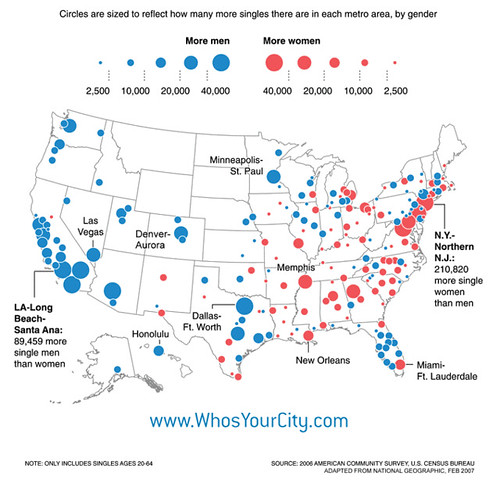
Above, you are looking at a map of the distribution of single people in the United States. Places with more men than women are shown in blue, places with more women than men are in red. So, you know, if you want to maximize your numerical odds, take heed. I’m just sayin’.
This map is one of many in Richard Florida’s new book, Who’s Your City? Florida is an academic and regional economist at the University of Toronto and best selling author of The Rise of the Creative Class. I can’t decide if the new book is only fluffy fun or there’s something more profound to it but, if you’re interested in cities and the way people live, you might find it enjoyable in either case.
Florida, like the scholars and analysts I wrote about some time back, is into megaregions, the conglomerations of neighboring metropolitan areas that roughly constitute distinct geographic regions linked by culture, environment, and economy, such as the Washington-to-Boston megalopolis or the “Texas Triangle” of Dallas/Fort Worth-Austin-Houston. His megaregions are not precisely identical to those of the people I am working with, but they are generally very similar. And, while the Jonathan Barnetts (Smart Growth in a Changing World) of the world are primarily interested in settlement patterns, the environment, and the economy, Florida’s most interesting observations are cultural in nature. Take a peek below:
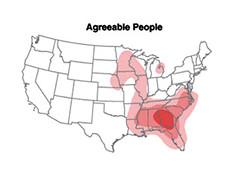
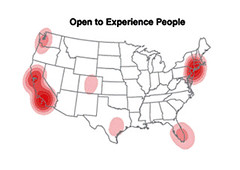
Florida finds that there is almost no overlap between the places with the most “agreeable” people and those with the people most “open to experience.” Hmmm. (I'm thinking this could be somewhat self-fulfilling, since many residents of places not considered "agreeable" are going to disagree.) Florida also finds that, in general, the creative part of the economy is growing in importance, along with the service industry, while manufacturing and agriculture are diminishing in importance. That’s not exactly news - except, perhaps, to the underemployed artists and musicians I know - but it’s still interesting to see it charted:
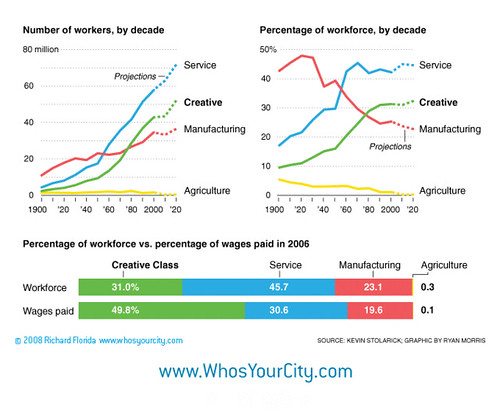
Geographically, the creative part of the economy is distributed like this:
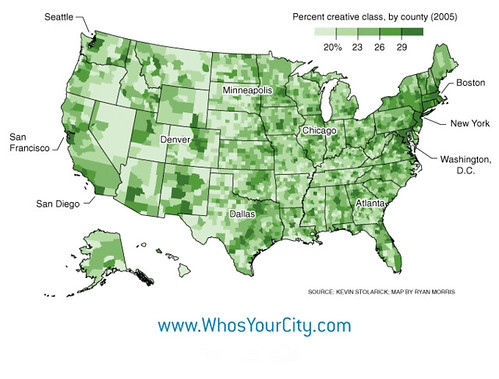
Florida’s basic point is that these differences in culture have a relationship to the economy, and can be measured and provide a more sophisticated template for making life decisions about where one might prefer to locate. He even offers a handy tool on his website called the “Place Finder” to convert personal lifestyle and work preferences into geographic choices. (It wasn’t working for me, unfortunately, but maybe my browser was having a hiccup or I didn’t have the patience to find the right link to click.)
Some of the "best cities" for young singles, according to the book: San Francisco, Madison, Boulder. Best for mid-career professionals: San Jose, Bridgeport, Durham. Best for empty-nesters: Seattle, Portland (ME), Trenton.
Lots more in the book, of course, and on Florida’s website. Incidentally, Marc Fisher of the Washington Post took Florida to task for being somewhat inconsistent in his attitude toward Washington, his former home, and Toronto, his current one. And then Florida replied in his blog. It’s interesting in part because the two know and respect each other.
Other famous people with interesting geographic names: Joe Montana, Robert Indiana, Utah Phillips, Patsy Montana, Joe Tex, former DC mayor Walter Washington, Sweet Georgia Brown. Can you think of more?